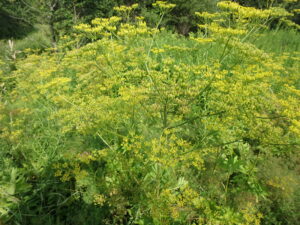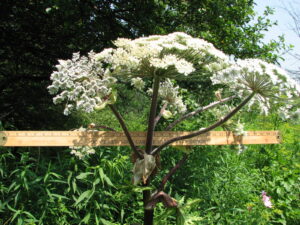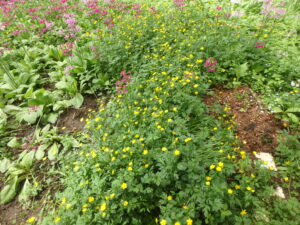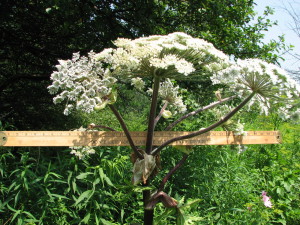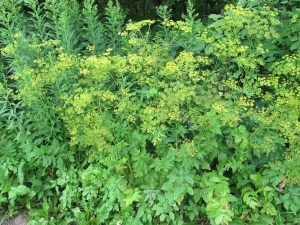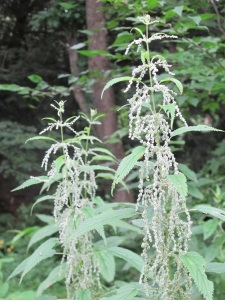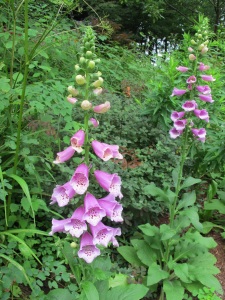Plants to Avoid If You Can
Avoid wild parsnips because you can get terrible burns from the sap of this plant. When the sap on you is hit by bright sunshine, most people develop painful blisters. This is unfortunate, as this common plant is spread by seed, often creating large patches in fields and along roadsides. If you get sap on you, wash it off with soap and water immediately, cover the area, and stay out of direct sunshine for 48 hours.
Giant hogweed (Heracleum mantegazzianum) is in the same family as parsnips, but is bigger, harder to get rid of, and even more toxic. I saw it for sale some 20 years ago and was intrigued by its size (6 to 12 feet tall) and blossoms that are up to three feet across. I bought it and planted it, having been told that it was not a perennial, though it is.
Another pest I have will surprise you, perhaps: buttercups (Ranunculus repens). Like some of the others mentioned above, at first I welcomed this bright harbinger of spring which displays cheerful yellow blossoms. But it has become a problem because it spreads not only by root, but by seed, and once established it is difficult to weed out. And it will choke out other plants. It is glorious in bloom, but very tenacious. If you have moist, rich soil in part shade, watch out. I’d advise removing it early before it starts crowding out other plants. This one is native to Europe, but there are native species that are not a problem, I am told.
I dug out all the goutweed, took away the soil down to 12 inches and replaced the soil after putting down a heavy weed mat. Still … 5 years later it crawled out from under the mat. If you have it, accept you will probably always have it, though with persistence and a good weeding tool, it is possible to control. But I wouldn’t buy a house that has it!
Three Plants to Avoid
Learn what it looks like, and avoid it. Sap from the stem, if on the skin and exposed to direct sunlight, can cause horrible burns. Not everyone reacts, however. Assume you do. If you get sap on you, go inside IMMEDIATELY and wash the affected area thoroughly.
First or second year plants often show up in my garden near my stream, but can be hand-pulled. Look for plants with a square stem that quickly get 18 to 24 inches tall, and may have a reddish-brown tinge to their stems. Older plants get to be 3 to 7 feet tall or more. Leaves are long and narrow with a smooth edge, and they attach directly to the stalk – without an attachment stem. Leaves generally appear in pairs, across from each other on a stalk. Many flower stems arise from the main stem.
The most popular Norway maple is a cultivar called “Crimson King’. It has leaves that are a deep purple – almost black. Many cities and homeowners bought these 50 years ago and installed them. Removing them is difficult and expensive.
The leaves are a bit bigger and wider than sugar maples, but you can I.D. a Norway maple by picking a leaf. Look at the place where it snapped off: if it oozes a white sap, it is a Norway maple. If you have one, please consider having it removed. Your great grandchildren’s maple syrup depends on it!
Plants to Watch Out For
If you have a wet area or a stream on your property, you might be seeing some very pretty tall pinky-purple flowers blooming now, or soon. Those are purple loosestrife (Lythrum salicaria), an invasive plant that you should not encourage. Mature plants develop massive root systems and can produce up to a million seeds in a year. It’s one of several plants you should watch out for.
So what can you do? First, learn to recognize purple loosestrife when it first grows, even before blooming. It has a square stem, and it is often reddish or brownish at the base. The leaves are long and thin. Each year I try to find time to cut back the stems more than once, reducing its vigor and preventing it from blooming. I pull new plants, but the established ones can’t be weeded out.
Purple loosestrife came from Europe long ago, and there it is not a problem – it evolved along with insects that eat it and keep it from becoming a pest. One of those beetles has been approved for release in the United States and is helping to control loosestrife in some places, but the beetles are not for sale. By cutting it back, I am acting like a big beetle.
Another bad actor is giant hogweed (Heracleum mantegazzianum). It is a huge plant – often more than 6 feet tall, with huge palmate leaves (shaped a bit like maple leaves, or your hand) and numerous small white flowers arranged on umbels (umbels are like the stays of an umbrella) that can exceed 3 feet in diameter. I bought one once, before I knew it was invasive. It can grow anywhere – sun or shade, wet or dry – and has a tap root that goes down two feet or more. Worse yet, the sap is highly toxic to many people and can create severe burns and even scars – particularly if you get exposed to it in full sun.
Fortunately, I am not allergic to hogweed, and I was able to rid myself of it by digging it out with my long drain spade, a shovel with a blade that is only 6 inches wide, but 16 inches long. On the other hand, it is a fabulous looking plant and wish I could safely grow it. It is on the invasive species list in many states.
A similar plant growing by the roadside right now is wild parsnip (Pastinaca sativa). This, too, has a sap that can burn the skin of many people (but not me). It only grows four feet or so tall, and has a yellow blossom like Queen Anne’s Lace. It is related to carrots – and giant hogweed. According to Sam Thayer’s wonderful book, The Forager’s Harvest, the tall plant we are seeing now is biologically identical to the parsnips we plant in the garden. It is a biennial plant, and Thayer eats the first year wild parsnips, but explains the second year roots are not edible. He states that wild parsnips look a lot like water hemlock, which is extremely poisonous. So do not take any chances!
Stinging nettle (Urtica dioica) is another pest – but one that has its virtues. It can grow almost anywhere, but does best in rich, fertile and moist soils. It has tough little hairs that act as hypodermic needles, delivering a cocktail of chemicals that sting and can produce a rash. Cooking or drying the leaves, however, eliminates the sting and nettles have a long history as an edible plant and medicinal herb.
Nettles can be cooked and eaten like spinach early in the spring. At this time of year the stems and leaves have gotten tough and are not recommended for eating. The plant itself gets to be 5 to 8 feet tall with leaves in opposite pairs that have toothy margins. It is very nutritious – it is up to 25% protein when dried. When dried, it makes a tea that I don’t like very much. Nettles are a good source of Vitamin C and A. I generally leave stinging nettles alone, though I pull them, wearing gloves, if they get into a flowerbed or too close to a path.
Three lovely garden plants that I grow have potentially poisonous side effects: castor bean (Ricinus communis), angel’s trumpet (Datura spp.) and foxglove (Digitalis purpurea). All three have poisonous seeds and (to a lesser degree) leaves. I don’t worry about them because I can’t see anyone – even a child – eating them. Castor beans and angel’s trumpet both have spiny coverings on their seed pods, and foxglove plants have very tiny seeds.
Castor beans can be used to make ricin, a very poisonous powder that can be fatal if inhaled or ingested. In 2013 a crazy guy sent ricin in a letter to President Obama. Fortunately, like kings of old who had tasters, he doesn’t open his own mail. But the plant is big, with palmate leaves in tones of red or bronze. I find it easy to start from seed.
Angel’s trumpet is my substitute for Oriental and Asiatic lilies, which are so badly attacked by lily-leaf beetles that hand-picking daily can’t keep them looking good. Unlike the lilies, it blooms all summer! It comes in white and purple-flowered varieties; the white ones are much more vigorous.
Foxglove is an old favorite of mine. It’s a biennial that produces pink-purple blossoms on tall stems. If you let it, it will drop seeds to the soil, and, in two years will bloom again unless you have s thick layer of mulch, which will inhibit the seeds.
Knowing your plants – and any potential negatives – is important, especially if you keep animals who are likely to nibble on your plants.
Henry is the author of 5 books. His websites are www.Gardening-Guy.com and www.henryhomeyer.com.



